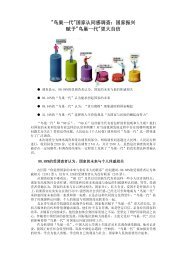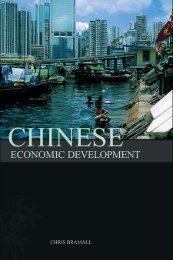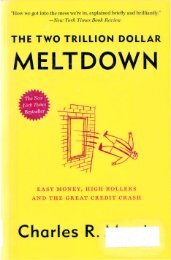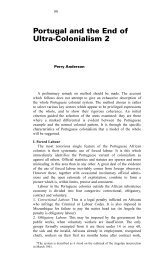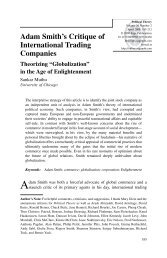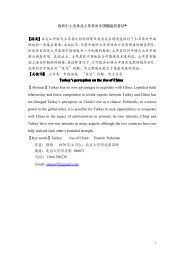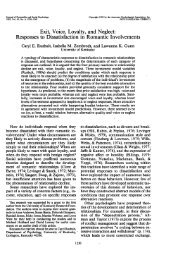Battle for China's Past : Mao and the Cultural Revolution
Battle for China's Past : Mao and the Cultural Revolution
Battle for China's Past : Mao and the Cultural Revolution
Create successful ePaper yourself
Turn your PDF publications into a flip-book with our unique Google optimized e-Paper software.
THE BATTLE FOR CHINA’ S PAST<br />
climate in <strong>the</strong> 1970s, an initiative that was hailed as ano<strong>the</strong>r ‘liberation’.<br />
Even when a television programme provides accounts of<br />
China’s success in feeding its huge population, it may use pictures of<br />
Xiaogang Village as <strong>the</strong> background. However <strong>the</strong> media <strong>and</strong> those<br />
who join <strong>the</strong> chorus fail to mention how much <strong>the</strong> state has donated<br />
to this village to promote it as a model of <strong>the</strong> household responsibility<br />
system. In spite of government’s pouring money into <strong>the</strong> village<br />
it is still poor today, so poor that its leaders are reported to have<br />
visited <strong>the</strong> still collectivized Nanjie Village to consider <strong>the</strong> possibility<br />
of re-collectivization (Yuan Wenbiao 2006).<br />
The official history propagated by <strong>the</strong> media claims that <strong>the</strong> dismantling<br />
of <strong>the</strong> collective system by Xiaogang Village was so effective that<br />
grain output in <strong>the</strong> village increased from an annual 30,000 jin to 120,000<br />
jin in 1979. What <strong>the</strong> media do not want to reveal is that 30,000 jin was <strong>the</strong><br />
yield in 1978 when <strong>the</strong>re was a terrible drought, whereas on average <strong>the</strong><br />
annual output was 190,000 to 200,000 jin during <strong>the</strong> collective period. In<br />
1979, <strong>the</strong> year when <strong>the</strong> l<strong>and</strong> was divided up, <strong>the</strong> output actually went<br />
down 40 per cent compared <strong>the</strong> annual average under <strong>the</strong> collective<br />
system. Some years later <strong>the</strong> media claimed that in 1997 <strong>the</strong> village<br />
yielded an output of 1,200,000 jin, indicating that this was a tremendous<br />
success of post-<strong>Mao</strong> re<strong>for</strong>m. Again what <strong>the</strong> media did not say is that <strong>the</strong><br />
figures were <strong>the</strong> total amount of grain yielded in several villages that<br />
had been amalgamated <strong>and</strong> were jointly renamed Xiaogang Village (Lao<br />
Tian 2007b).<br />
Ano<strong>the</strong>r aspect in manufacturing <strong>the</strong> truth about this village is also<br />
revealed in <strong>the</strong> e-media. In 1978, due to <strong>the</strong> drought that year, o<strong>the</strong>r<br />
villages all started to contract responsibility to small teams while still<br />
maintaining <strong>the</strong> collective system. However, <strong>the</strong> situation in Xiaogang<br />
Village was so divisive <strong>and</strong> <strong>the</strong>re was so much internal tension, even<br />
among members of <strong>the</strong> same lineage, that <strong>the</strong>y were not able to <strong>for</strong>m<br />
teams. It was under <strong>the</strong>se circumstances that <strong>the</strong> village head Yan<br />
Junchang decided that <strong>the</strong> l<strong>and</strong> was to be carved up among <strong>the</strong> households.<br />
The so-called historical act had nothing to do with <strong>the</strong> villagers’<br />
courageous rebellion against <strong>the</strong> collective system. It had more to do<br />
with <strong>the</strong> village leaders’ inability to get <strong>the</strong> village organized.<br />
The legacy of <strong>Mao</strong> <strong>and</strong> <strong>the</strong> e-media<br />
In<strong>for</strong>mation of this kind can be increasingly seen in <strong>the</strong> e-media <strong>for</strong><br />
three main reasons. The first is that <strong>the</strong> consequences <strong>and</strong> problems of<br />
<strong>the</strong> re<strong>for</strong>m policies are now being seen <strong>and</strong> felt by <strong>the</strong> majority of <strong>the</strong><br />
people, as discussed in o<strong>the</strong>r chapters. There is backlash against at<br />
least some of <strong>the</strong> re<strong>for</strong>m policies. 9 The second reason is that e-media<br />
has become more user-friendly <strong>and</strong> more accessible. As a result <strong>the</strong><br />
[ 156 ]





